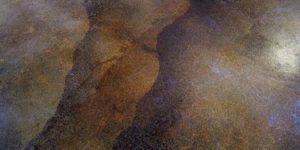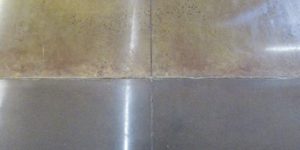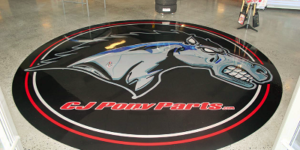It’s that time of year again – the time when I review the hundreds of questions and situations I dealt with in 2010 looking for those special few that made me pause and just think, “Really?”
There is no shortage of situations to choose from. In fact, it seems that the number of off-the-wall and strange-but-true questions and situations only seems to grow each year. Those that make the cut are rolled into this “best of ” column. I hope you enjoy a snapshot of what I think is the funny, the bad and the ugly when it comes to helping the industry solve problems.
The great gasoline gaffe
Let’s start with one of my favorites from 2010. It was early spring, and I, along with a decorative installer, were visiting a stain job he had recently completed. The project was part of a small strip mall that was under various stages of construction. After walking the floor and discussing various “why,” “where” and “when” aspects of the stain job, we noticed a fair amount of commotion going on next door, where a large foundation slab was being finished with ride-on power trowels.
Apparently someone on the finishing crew thought a lubricant was needed to aid the power trowels as they made their last few passes across the slab. Apparently no water was readily available, but quite a few gas cans used to fuel the power trowels were sitting close by. Do you see where this is going? Needless to say, one of the finishers started emptying a gas can onto the concrete to aid in lubrication. At this point, myself, the stain contractor, and almost everyone else were moving quickly and with purpose to get a safe distance away from the gas-soaked concrete.
Our pyromaniac power-trowel driver jumped back up on his machine and within minutes of gliding along the now gas-lubricated surface caught a rock and sparked off the slab. I would be lying if I said it was a magnificent explosion seen for miles, but the initial orange flame crawling across the slab accompanied by the whoosh of igniting gas fumes was impressive. The finisher was fine, expect for a few singed hairs and a true sense of embarrassment. I have to say that actually seeing a slab of concrete ignite and burn with a Sterno blue flame for 20 seconds did create a lasting impression. I am not sure if this scenario is ready for “Jackass: the Movie, Part IV, ” but it’s not something you see every day, and that’s a good thing.
Arguing with labels
A question I often get deals more with the person trying to change my mind to appease their sense of urgency than with any actual application process. I often wonder why some people think that if they ask the same question 27 different ways, the answer might somehow change. For example, the classic and most common of these types of questions is the “how long to wait before applying sealer ” question.
“I have a new stained or colored or stamped or whatever concrete slab, and I am having the plant of the month club over this week, and I want to know if I can seal it today, or do I REALLY need to wait the 28 days as clearly stated on the directions?”
Depending on my mood, the answer can vary from a detailed explanation of why it is important to wait to sarcasm: “No, you don’t have to wait, but it will probably fail within six months. ”
This exchange is often followed by a laundry list of irrelevant details from the user, then the same question, “Do I have to wait the 28 days to seal, ” asked again. This begins another back-and-forth between me and the persistent questioner, with the same result. In the end it becomes painfully obvious that all they want is the smallest amount of “maybe ” from me, which will give them the confidence that breaking the rules, cutting corners and just plain lack of common sense might actually pay off. It is also not surprising that six to 12 months later these are the same people who are back asking how to deal with a sealer failure.
Heat stroke of genius
Last but not least in the crazy category is the sealer situation of the year. Our story begins with a typical sealer complaint. A contractor was looking for a full refund for sealer purchased from a distributor, stating that the product did not work at all. In fact, the sealer was so faulty that his roller actually stuck to the surface as he rolled the sealer down. Having heard this, my interest was piqued. I had to dig into this further to see what exactly would cause a liquid sealer to flash off so fast it became glue.
Well, as with most complaints, the devil is in the details, and it did not take much to uncover those associated with this issue. The job took place in southern Colorado in late July. The daytime temperature was hovering right around 100 F with a warm wind blowing about 15 to 20 knots. There was not a cloud in the sky, with the sun beating down hard. The applicator picked midafternoon to start applying the sealer. Most would say this was the absolute worst time to even consider sealing concrete, right? Well, not for our unsuspecting contractor, who not only failed to read the directions and limitations but also had a lapse of common sense.
Oh yeah, I also forgot to mention that the project in question involved sealing dark concrete pavers on a rooftop – so you can add another 10 F in surface temperature. Needless to say, I had a hard time composing myself when the contractor started to complain to the distributor, demanding a refund and going on about the product being defective. When asked to produce the smoking gun, he brought in the roller firmly embedded in a pan of sealer that was rock hard. This roller with attached handle now makes a nice coat hanger in the distributor’s showroom. As far as the contactor and his claim, a quick read through the application guidelines and the case was closed.
As we close out another year, I sense that 2011 will hold good things for the industry. The last three years have been hard, but those that survived are in a better place to face the challenges that lies ahead. I look forward to a new year and to helping solve more problems in and around the decorative concrete industry.















